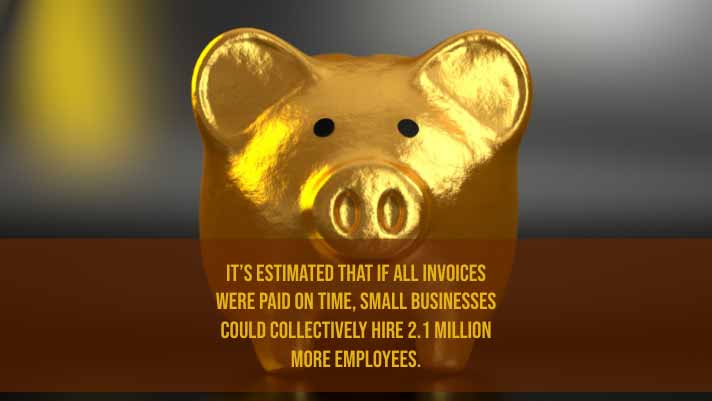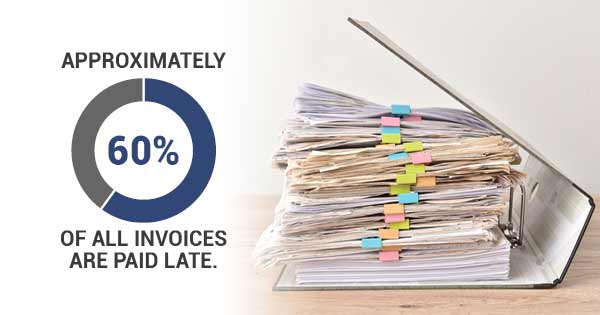Invoicing is an expected burden of business. When selling to other businesses, credit terms and invoicing are a part of the package. This means that a simple delivery of goods or services performed can become more complicated with the drafting, delivery, and collection of invoicing. However, there are common mistakes or problems involved in the invoicing process that you have control over. Here are the most common invoicing problems and how to avoid or fix them!
Common Problems with Small Business Invoices
- Having the wrong contact or address
- Waiting to send the invoice
- Not confirming receipt of invoice
- Errors within the invoice
- Forgetting basic invoice components
- Not following up before payment is due
- Complicated payment process
- Adding hidden costs
- Losing the invoice before delivery
- Not being paid on the payment due date
Addressing the Wrong Contact
The first step to invoicing a client is sending the invoice to the right person. This means that you want to send Company A an invoice for goods delivered or services performed for Company A. Company B would be confused to receive an invoice for goods or services they had nothing to do with! On top of having the right company, have the right person. Is there a specific accounts payable department that you should be invoicing? It does no good to go through the work of drafting and sending an invoice if it goes to a generic sales email. List the correct contact information for the department that handles the invoicing within your customer’s company. Having the right contact means having the correct name, address, email address, phone number, and company name. And be sure not to misspell anything!
Contact Information to Check Before Sending:
- Contact name
- Contact address, email, and phone number
- Company name
Waiting to Send the Invoice
There is no benefit to your company waiting to send an invoice to a customer. If you have performed a service or delivered goods, send the invoice! The sooner your customer receives an invoice, the sooner they can pay you. Waiting to send the invoice only hurts your cash flow.
Not Confirming Receipt of Invoice
Many businesses simply don’t contact their customers to verify the receipt of their invoices. This is such a small task that can prevent so many issues down the road. First off, calling or emailing your customer to verify that they received your invoice can ensure that the invoice amount and due date are correct for both parties. If there is any sort of discrepancy in the quantity, quality, or timeliness of the goods or services, your customer can tell you sooner rather than later. Verifying that everyone is on the same page about how much and when the payment is due just takes you one step closer to collecting payment for your hard work. If there are any issues or questions to sort out about the work completed, it’s best to know about them and remedy the situation immediately, rather than the payment deadline coming and going and still no customer payment.

Further still, if you are sending invoices by mail, it can get lost. Maybe the payment deadline comes around and your customer claims that the invoice you emailed went to their spam folder so they never received it. A simple call to confirm the safe delivery of your invoice mitigates all these problems.
Errors within the Invoice
Make sure there are no spelling or numerical errors in your invoice. This means accurately listing (and even itemizing) the goods and services along with costs. Each invoice should include a specific invoice number. It is so important to have the right invoice number on the document. These are used for classification and for reference in case a payment dispute arises. Also spell both contact and company names’ correctly. Have you ever received a check with your name misspelled? It becomes a huge pain to sort out the issue. Get it right the first time, and cover your bases.
Forgetting Basic Invoice Components
At BARE MINIMUM, your invoice needs to have both parties’ contact information, the invoice amount, the services performed or goods delivered, payment instructions, payment due date, invoice creation date, and an invoice number. It’s best to also include detail with the transaction, costs, and all dates involved. For instance, having a date of invoice creation and a date of shipment or delivery means that you can reference these dates in the case of any customer inquiry or dispute. As stated above, having a specific invoice number for each invoice sent makes filing and referencing transactions simpler. It’s important each invoice has a unique number attached even if it is a repeat customer.
Basic Invoice Components:
- Dates
- Names and Addresses
- Contacts
- Sale Details
- Payment Terms

Not Following Up Before Payment is Due
Business would be much simpler if everything was just ‘sell and forget.’ Unfortunately, collecting payment from your customers can be a longer process than the delivering the goods or services in the first place. Even sending an invoice immediately and expecting payment on or before the payment due date can still lead to customer nonpayment. Contacting your customer to ensure they received the invoice is a good first step. The next step is contacting them closer to the payment due date with a gentle reminder. Keep this communication brief and courteous. After all, you aren’t accusing them of not paying or of planning not to pay. You are simply reminding them that there’s a deadline coming up. It’s a courtesy reminder, not an accusation.
Small business owners juggle a lot of tasks in their day-to-day. This reminder can help make sure your customer pays you on time. In fact, if there is a reason they foresee not being able to pay before the deadline, this is their opportunity to bring it up to you now rather than waiting. This way, you can work out a payment plan that works for both parties. It’s better to get back some money rather than no money.

Complicating the Payment Process
It’s nice to offer payment options to your customer. They can be an automated clearing house (ACH) payment, check, cash, bank transfer, or online portal. If you have more than one option to pay your company, make sure you clearly list the options and have them readily accessible for your customer to access. The simpler it is for your customer to pay you, the faster they are able to make the payment. Having a complicated payment process where they have to contact you to figure out how to send the money they owe will only hurt your relations and discourage future transactions because of the hassle. Some companies offer to collect payment on your behalf. If this is the case, make sure your customer is following their process and assure them that the payment will be made out correctly in your payment instructions.

Adding Hidden Costs
If you hire a plumber to come fix your sink, you don’t want to receive a bill that includes extra costs for services you didn’t previously agree. The same goes for businesses. Don’t send an invoice amount for costs that were not clearly stated to your customer. Hidden fees make business owners weary. All parties should be in agreement of what the transaction was for and how much it costs. If there were any additional fees to the basic services or goods, be sure to have a clear explanation for why they are being passed on. A customer may refuse to pay an invoice amount that comes with surprises. The legal process of trying to collect from your customer may be more than the hidden fee to begin with.
Losing the Invoice Before Delivery
If you send the invoice immediately and call to verify receipt of the invoice, this should not be a problem. Unfortunately, business owners report losing invoices as a problem for invoice payment. If your customer happens to lose the invoice you sent, the follow-up call reminding invoice payment is due gives you an opportunity to email over another one. There shouldn’t be any excuses for customer non-payment if you stick to the basics of invoicing.
Not Being Paid on the Payment Due Date
There is only so much you can do to ensure payment on your open invoices. Unfortunately, around 60% of invoices are paid late. This is due to poor invoicing practices in combination with cash flow problems. Small businesses disproportionately face cash flow issues compared to larger firms. There are many factors, but lengthier credit terms that large companies set when purchasing from small businesses mean that these smaller companies take the brunt of cash flow gap. Customer non-payment can be brutal for a small business owner, and the collections process can be long and expensive.

Collecting Payment from Late Customers
Late paying customers can create a trickle effect. When you don’t receive the cash you are owed on time, it can strain your finances when paying your own costs. Overhead, suppliers, and employees need to paid on time. The downside to selling on credit terms is the gap between goods delivered, services performed, and payment received. Collecting payment from late paying customers can be time and resource draining. This is where an invoice factoring company can help you. Factoring companies are not debt collection agencies. Instead, they partner with small businesses to advance payment on open invoices. Then, they wait the duration of credit terms and collect from your customer. Depending on what facility you choose, the factoring company can be on the hook for customer non-payment, not your business.

In addition to managing receivables, collecting invoice payments, and improving your cash flow, factoring services include credit monitoring to mitigate the risk of customer non-payment in the first place. Accounts receivable management can be daunting for a business that doesn’t have a deep accounting department. Outsourcing these duties to an accounts receivable factoring company can lower your overhead. Correcting invoicing problems ensures your business gets paid on time for the work you perform. Partnering with a factoring company leaves the time consuming process of collecting on invoices to them and frees up your time to continue making sales and growing. What could you do with instant payment for your goods or services?


